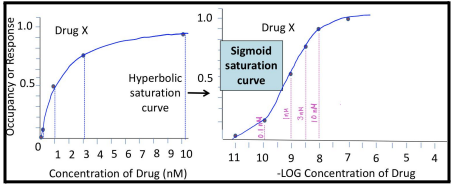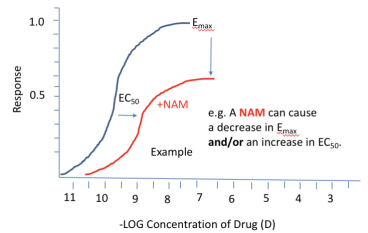Pharmacodynamics
What the drug does to the body...
Assumptions
- Dose-dependent: Response depends on concentration
- Mass-action relationship: The rate of the reaction is proportional to the mass of reactants (drug concentration pushes equation right)
- Occupancy assumption: Magnitude of response is proportional to the fraction of receptor sites occupied
- Binding is does not effect drug concentration: Number of drug molecules is more than enough to occupy all receptors.
Forces involved in drug-receptor interactions (binding energy)
- Lipophilic
- Hydrophilic
- Iconic
- Steric hinderance
- Hydrogen bonding
- Electronic effects
- pK effects
Dose-Response Curve
As concentration increases, the response increases until a maximum is reached, referred to as Emax which is analogous to Vmax.
Equilibrium dissociation constant (Kd)
Analogous to Km, or the binding affinity. At equilibrium, Kd is the ratio of free drug to the bound drug.
[D] = drug concentration
[R] = receptor concentration
[DR] = bound drug/receptor complex
Fractional Occupancy (FR)
The fraction of receptors occupied at a given drug concentration.
[D] = drug concentration
[R] = receptor concentration
[DR] = bound drug/receptor complex
Kd = Equilibrium dissociation constant
According to this equation, the maximum possible response (Emax) is proportional to the number of receptors, while the maximum observed response (effect e) is proportional to the percentage of bound receptors (FR).
e = observed effect size
Emax = maximum response
Plotting
Taking a look at concentration vs. response, the curve is hyperbolic (slope decreases as a function of the concentration). For drugs with a large concentration range, the x-axis is negative log scaled, often resulting in a sigmoid saturation curve.

Population modeling
ED50: Dose to achieve a threshold drug effect in 50% of the population
TxD50: Dose which creates toxic effects in 50% of the population
LD50: Lethal dose in 50% of the population
Therapeutic index (TI): The margin of safety for a drug. Defined as either TxD50 / ED50 or LD50 / ED50.
The standard model of safety (SMS) can be used if the therapeutic and toxicity curves are not parallel with increasing dosage. This is defined as SMS = TxD1 / ED99. The larger the SMS (high dosage required to achieve toxic effect, or low effective dose), the safer the drug.

Efficacy and Potency
Efficacy is a term which describes the ability of a drug to produce a response (along with power or intrinsic activity). Potency is a term which describe a drugs ability to bind to a receptor (along with affinity, Kd, EC/ED50 ect.).
The efficacy can be found by using the Emax. For example, two drugs can have the same efficacy at different concentrations.
The potency can be found by using the drug concentration, or the concentration required to reach 50% receptor occupancy. This is referred to as the EC50. In simple systems, Kd will equal EC50.
Agonism
Agonists bind to receptors and activate them, facilitating a physiological response. An in the active state is denoted as R*. When two drugs both operate at the same site, but both under their respective Emax's, their effects will be additive. If the two drugs bind at different sites but still exhibit a positive effect, the effect is synergistic.
Constitutive activity pertains to receptors that are capable of activating without a ligand binding. Receptors can exist in an R* state even in the absence of an agonist.
A full agonist binds to a receptor and elicits a maximal response. High affinity for R* and low affinity for R.
A partial agonist binds to the receptor but elicits a sub-maximal response. High affinity for R* and moderate affinity for R.
A neutral agonist (antagonist) produces no response. It has equal affinity for R* and R. This will compete to block agonists.
An inverse agonist will bind to the same receptor as an agonist and elicit an opposite response. Therefore, it is only recognizable at high constitutive activity by deactivating these default-activated receptors. It will has low affinity for R* and high affinity for R.

Antagonism
Pharmacological antagonism occurs when the agonist and antagonist work on the same receptor, while physiological antagonism occurs when the antagonist binds a different receptor and exerts the opposite effect as the agonist. An example would be a beta-adrenergic agonist (increases HR) and a muscarinic cholinergic agonist (decreases HR).
Chemical antagonism is when the drug doesn't bind to a receptor, instead interfering with the agonist directly. Heavy metals for instance.
On-site binding
When an agonist binds at the same location as the antagonist, it is competitive inhibition. This will drive the EC50 to the right, requiring more concentration to achieve 50% receptor binding.
Off-site binding
When a modulator binds off-site, the effect on the drug can be positive or negative.
A negative allosteric modulator (NAM) decreases the response, shifting Emax down (lower efficacy) and/or EC50 right.

A positive allosteric modulator (PAM) increases receptor activation, shifting Emax up (higher efficacy) and/or EC50 left.

Major Receptor Classes
| Ligand | Effects | |
|---|---|---|
| Ion Channel | Nicotinic cholinergic, glutamate, GABA | Ion flux (Na/K/Ca/Cl) |
| GPCR | Adrenergic, muscarinic | 2nd messengers (cAMP, IP3, prostaglandins, ect.) |
| Growth factors/cytokines | EGFs ect., interferons | Protein kinases (phosphorylation) |
| Transcription factors | Estrogen | Transcriptional regulation |
| Enzymes | HMG-CoA, PDE, MEK, cholinesterase | Enzyme inhibition/activation |
| Protein interactions | BCR/ABL, EWS/Flit-1, BCL-2/BH3 binding | Example: Venetoclax for chronic lymphocytic leukemia |
| DNA/RNA | siNRA, antisense | Alters coding regions |
Receptor Reserve
Not all receptors need to be occupied to get to Emax. This is why EC50 and Kd are not always equal. Kd is occupancy, which EC50 is function.
Receptor Regulation
Disuse sensitivity occurs when a chronic antagonist leads to an increase in response to an agonist. Desensitization/downregulation is the opposite, when chronic agonist leads to a decrease in response.